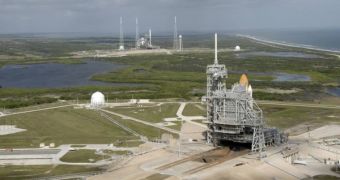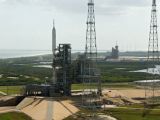For the first time in the history of the American space agency, the Kennedy Space Center has two completely different rockets poised for take-off at their respective launch pads. Both of the designs already carry, or will carry in the near future, astronauts to the low-Earth orbit, or other destinations closer to home. At Launch Pad 39A, the space shuttle Atlantis patiently awaits for its November 16 flight, while, at the other pad, the prototype ARES I-X is poised for its launch today, at 8 am EDT (1200 GMT). There is a 40-percent chance that the weather will allow for the launch to go on, Space reports.
Weather officials at the space center alerted mission controllers two days ago that there was a significant chance the spacecraft would not be able to perform its suborbital test flight today. “Our weather on Tuesday is going to be a little bit of a problem. I feel more optimistic about Wednesday than Tuesday,” weather officer Kathy Winters said on Sunday.
The weather conditions needed for the new ARES I-X launch are a lot more drastic than those needed to launch the space shuttles atop their external fuel tanks. A phenomenon known as “tribo electrification” poses a lot of threats to the new rocket. As it climbs through the clouds, the friction force causes electrical charges to build up, which can severely affect the electronic navigational systems aboard the rocket. Previous test flights have proven that the space shuttles are immune to this risk, having already been constructed so as to overcome it.
There are those who say that the shuttle may be damaged if ARES I-X fails its test. That is to say, the new rocket may explode, or be torn up by vibrations and then debris could fall over Atlantis and its external fuel tank, causing massive damage. Mission planners at NASA alleviate these concerns, saying that there is a chance of about 1 in 10,000 of that happening. The probabilities are a bit higher for ARES I-X, because this is the first time in more than 25 years when the space agency tests a new rocket, and there are numerous new systems that could malfunction during the launch attempt.
The goal of the flight is to assess the integrity and functionality of the first stage motor, and also to determine if the separation system between the first and second stages is working properly. A number of ground-based systems will also be tested, as well as the operations associated with them. The craft, which is a precursor of the ARES I rocket – that will fly the Orion Crew Exploration Vehicle to the low-Earth orbit –, is also outfitted with a bogus second stage and payloads, so that the test mimics the actual launch conditions for ARES I as faithfully as possible.

 14 DAY TRIAL //
14 DAY TRIAL // 
